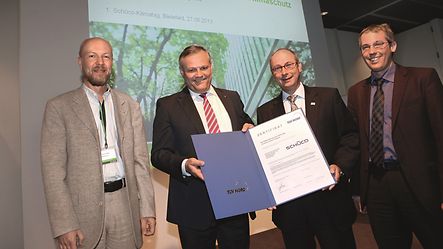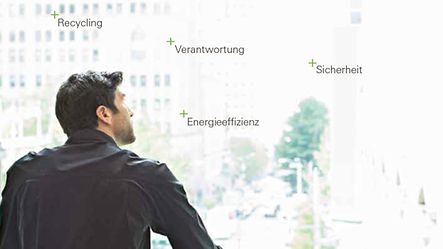CO2-Balance
Schüco has already employed diverse measures with the aim of reducing greenhouse gas emissions. For example, a building monitoring system was introduced across all of the sites, the heating in large sections of the headquarters in Bielefeld was switched to lower emission district heating, and new system management tools for optimising transport logistics were introduced.
MEASURES TO REDUCE CO2

Furthermore, since 1 January 2012, all Schüco sites in Germany have been purchasing green energy. It has therefore been possible to lower the energy-related emissions to less than 10% of the previous value. Other measures affect paper consumption and printing, as well as the framework for business trips and travel, including the associated guidelines, information and awareness campaigns. The focus here is on the Schüco employees who, with their conscious actions in their daily work and their commitment to implementing environmentally-friendly measures, make a considerable contribution towards reducing the CO2 emissions.
CALCULATING THE CARBON FOOTPRINT FOR SCHÜCO GERMANY
Verification process
To calculate the Schüco carbon footprint, data is gathered each year on the CO2 emissions produced through energy consumed for power, cooling and heating all of the buildings, for transport logistics, business trips, journeys to and from work, as well as for paper and printing. All of the primary data collected is verified by TÜV NORD CERT. The carbon footprint is calculated in accordance with the standard TN-CC 020: 2013-10.


Results
By regularly generating its CO2 balance, Schüco is laying the foundations for the sustainable reduction of CO2 emissions and improved energy and environmental management. The assessment takes into account all greenhouse gases relevant to the climate that are produced during the year through company and production processes in Germany. When calculated as CO2 equivalents, this amounted to over 74,000 tonnes in 2011. At more than 50%, the energy consumed by buildings, including for production, constituted the largest proportion, followed by transportation services, journeys to and from work, business travel, and paper and printing.
Even by 2012, Schüco was able to reduce its carbon footprint by more than a third, primarily due to the switch to green energy. Whilst the verified amount of CO2 equivalents was 74,292 tonnes in 2011, a figure of just 46,040 tonnes was calculated for 2012. At 40%, the energy consumed by transportation services accounted for the largest proportion of this figure.
For 2016, the CO2 balance shows total emissions amounting to 27,890 tonnes. The further decrease by almost 40% compared to 2012 can be attributed to a reduction in the scope of business activities and measures to save energy and increase energy efficiency.
By defining ambitious objectives and concrete measures, Schüco is taking ownership of the aims of the Paris climate summit and is making its contribution to the achievement of those aims.
